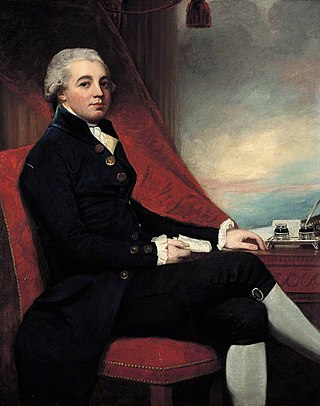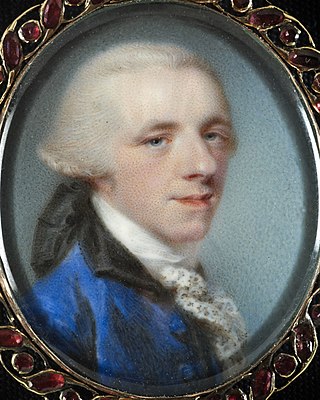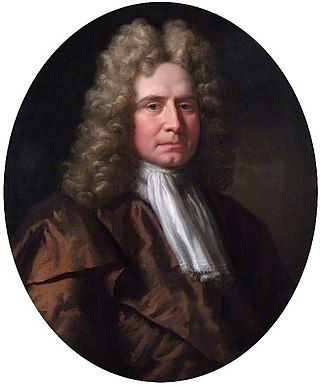Related Research Articles
William Manning was a British merchant, politician, and Governor of the Bank of England.

Thomas Raikes was a British merchant particularly trading from London with Russia, a banker and newspaper proprietor. Notably, he was Governor of the Bank of England during the 1797 currency crisis, when the Bank was prohibited by the British Government from paying out in gold.
George Morton Pitt was a Madras-born British politician and administrator who served as the President of Fort St George from 1730 to 1735.

Sir Richard Neave, 1st Baronet was a British merchant and a Governor of the Bank of England.
William Fawkener was Governor of the Bank of England from 1743 to 1745, having previously served as the Bank's Deputy Governor. He was son of another William Fawkener (1642–1716), a leading member of the Levant Company, and brother of Sir Everard Fawkener, who was also a merchant dealing in silk, before becoming Ambassador to the Sublime Porte between 1737 and 1744.

Sir John Eyles, 2nd Baronet of Gidea Hall in Essex, was a British financier and politician who sat in the House of Commons from 1713 to 1734. He was Lord Mayor of London in 1726. He served as a Director of the East India Company 1710-14 and again 1717-21 and was appointed a sub-governor of the South Sea Company in 1721.

Sir Nathaniel Gould was an English merchant and politician who sat in the House of Commons of England from 1701 to 1707 and in the House of Commons of Great Britain between 1707 and 1728.
George Heathcote was an English merchant and philanthropist and Tory politician who sat in the House of Commons from 1727 to 1747. He was Lord Mayor of London in 1742.
John Horsley Palmer was an English banker and Governor of the Bank of England.

John Olmius, 1st Baron Waltham, of New Hall, Boreham, Essex, was a British landowner and Whig politician who sat in the House of Commons between 1737 and 1762.

Sir Francis Eyles, 1st Baronet was an English merchant who was Governor of the Bank of England and a baronet in the Baronetage of Great Britain.

Humphry Morice was an English merchant, politician and slave trader who served as the governor of the Bank of England. He inherited his father's trading business around the age of eighteen, and learned finance and speculation from an uncle. Placed in Parliament through a cousin's interest in 1713, his Whig politics ultimately provoked a breach with his Tory cousin, and he had to be given another seat in 1722 by Robert Walpole's administration. He rose to be Deputy Governor and then Governor of the Bank of England in 1727, but unknown to his contemporaries, his fortune was largely fictitious and he was embezzling from the Bank and his daughters' trust fund. He died suddenly in 1731, perhaps having poisoned himself to forestall the discovery of his frauds, and left behind enormous debts.
Samuel Holden (1675–1740) was an English merchant, politician, and nonconformist activist.
Sir John Hartopp, 3rd Baronet (1637?–1722) was an English politician, a nonconformist and early Whig.

John Bristow, of Mark Lane, London, and Quidenham, Norfolk, was an English merchant, financier and politician who sat in the House of Commons from 1734 to 1768.
Sir James Bateman was an English merchant and politician who sat in the House of Commons from 1711 to 1718. He became Lord Mayor of London and Governor of the Bank of England.
John Rudge, of Mark Lane, London and Evesham Abbey, Worcestershire, was a London merchant and financier, and Whig politician who sat in the House of Commons almost continuously between 1698 and 1734. He was a Governor of the Bank of England from 1713 to 1715.
John Hanger was a merchant of Trinity Minories who was Governor of the Bank of England from 1719 to 1721 when the Bank of England was closely involved in the financing of the South Sea Company. His family were closely associated with the hundred of Bray in Berkshire and a memorial to the family exists in St Michael's Church there.
Edward Darell (1728–1814) was an English merchant and Governor of the Bank of England from 1787 to 1789.
Sheffield Neave (1799–1868) was an English merchant and Governor of the Bank of England from 1857 to 1859.
References
- ↑ Various. Curious Church Customs And Cognate Subjects. Library of Alexandria. p. 86. ISBN 978-1-4655-1504-9.
- ↑ Governors of the Bank of England. Bank of England, London, 2013. Archived here. Retrieved 14 February 2016.
- 1 2 The Story of Shoreham
- ↑ Lewis S. Benjamin The South Sea Bubble
- ↑ Oxford Dictionary of National Biography (online ed.). Oxford University Press.
{{cite encyclopedia}}: Missing or empty|title=(help)(Subscription or UK public library membership required.)